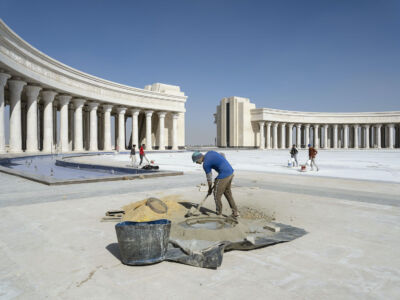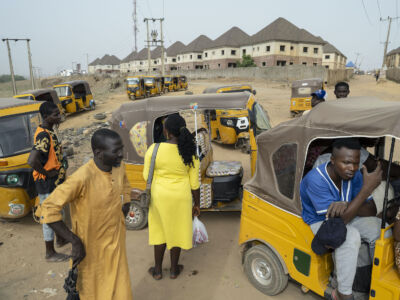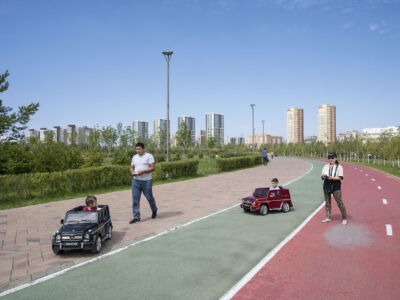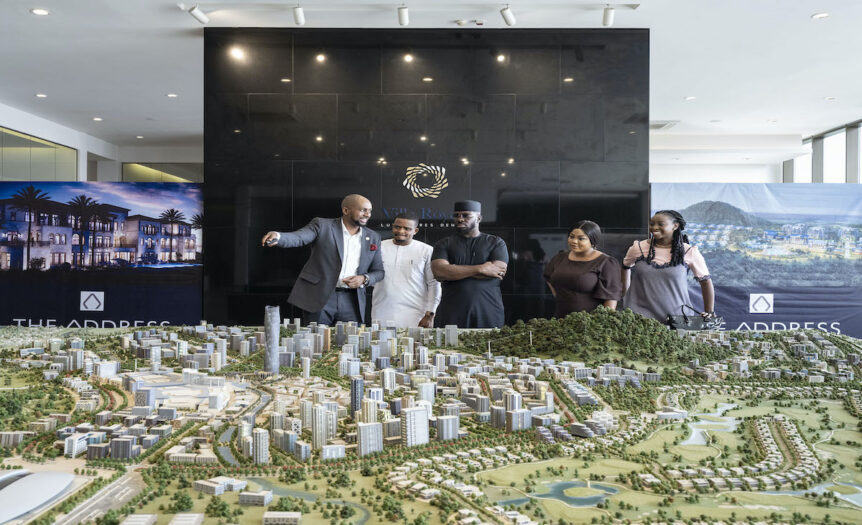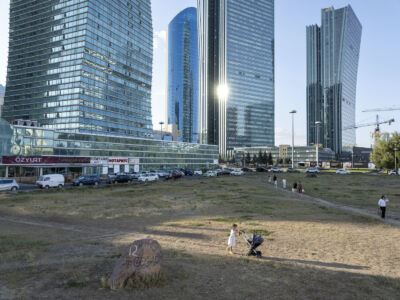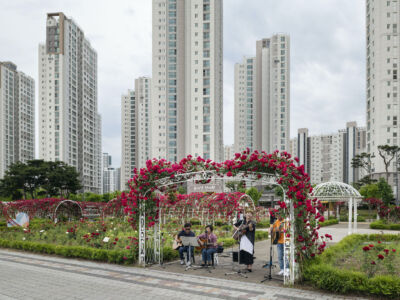What does the ideal capital city look like? Belgian photographer Nick Hannes travelled to six countries – Egypt, Korea, Nigeria, Kazakhstan, Indonesia and Brazil – that have recently built or are in the very process of building a new capital. Like a visual anthropologist with a keen eye for detail, Hannes sets out to discover the human dimension in a setting full of spectacle architecture and pompous prestige projects. Nick Hannes will be among the featured guests at Utopian Hours, the international festival on city making and urban innovation organized by Stratosferica, taking place from October 18 to 20 at La Centrale, Nuvola Lavazza, in Turin. Alongside over thirty international speakers, Hannes will present an exclusive preview of his latest work, “New Capital: Building Cities from Scratch”. You can find the full event program here.
Egypt
The six capital cities I photographed did not grow organically over the centuries but were built from scratch in a relatively short period of time according to a pre-designed master plan. In theory, building a new city offers the ultimate opportunity to organize a perfect urban environment. However, most of these capitals were not built to meet the needs of the population, but rather to perpetuate political power.
The most obvious example of this is Egypt’s New Administrative Capital (NAC). Located 50km east of Cairo, its construction started in 2016. Most ministries have been relocated here, and embassies, universities and headquarters of major companies will soon follow. The authorities aim for a population of six million by 2050.
The NAC is a prestige project of President Abdel Fattah el-Sisi, a former army general. The Egyptian military has great economic power: it owns both the land on which the NAC is being built and the main contractors involved. One could say that the NAC is a military project.
The NAC will be a highly exclusive city, where the majority of the Egyptians cannot afford to live. The city aims for the higher and upper middle class, high-ranking military and government officials. To purchase a property, permission from the authorities is required. Critics say this is a way to keep out political opponents.
The NAC will be a smart city, constantly monitored with 6000 cameras, sensors, cell phone trackers and drones. Everybody will be closely watched, and that is what el-Sisi is all about: building a prestigious power base, where protest such as the Arab Spring in 2011 will be impossible. In a surveillance state the smart city becomes a tool for political and social control.
Brazil
As the historical benchmark for this project, I chose to include Brasilia. Built in 41 months of time and inaugurated in 1960, Brazil’s new capital was meant to convey the spirit of a modern nation. Seen from the air, the core city takes the shape of an airplane as a symbol of progress.
One of the recurring characteristics of the new capitals is their monumental urban design, resulting in massive urban sprawl. To this day, this has dire side effects on mobility. Brasilia is a car-based city, where big distances make walking impractical. Moreover, the city was rationally divided into sectors. Commercial, residential and government facilities are separated.
Nigeria
With 220 million inhabitants, Nigeria is Africa’s most densely populated country. To relieve the overcrowded former capital Lagos, a new capital was built in the 1980s. Abuja was to become a leading and neutral city, strengthening unity within the ethnically divided country and spreading economic opportunities. In turn, Abuja became one of the fastest-growing cities in the world, with now almost 4 million inhabitants and a massive income gap. While a beer in one of Abuja’s bustling nightclubs costs 10 euros, 40% of Nigerians are living on less than one dollar a day. Yet Nigeria, Africa’s third largest economy, is not a poor country. The extreme inequality is not due to a lack of resources, but to the misuse of resources by the political and economic elite.
There is a real security issue in Nigeria. Jihadists and criminals have developed a thriving business model based on kidnapping and extortion. Those who can afford it therefore live in one of the many luxurious estates: private residential compounds surrounded by walls, razor wire and checkpoints. They are a typical example of capsular architecture: highly segregated safe havens, obsessed with security and control, secluded from the unpredictable chaos and danger of the outside world. The majority of the population however has less financial opportunities, and live their life in slums, scattered throughout the city and suburbs.
Kazakhstan
Since 1997 Astana is Kazakhstan’s new capital. As in Brazil and in Nigeria, the capital moved from the periphery to the center of the country. A strategic choice to emphasize the country’s unity. The new capital was to become the spearhead of post-Soviet nation-building thanks to oil and gas revenues. In no time Astana emerged as a Global City of more than a million inhabitants today.
Like the other new cities, Astana is a generic city; a city with no past, no historical stratification, no original inhabitants, no local character. A generic city is like an airport or a Hilton hotel room; they look the same everywhere in the world.
Inspired by Dubai, Astana is a playground for architects and property developers. The city has become an urban spectacle, a symbol of state power and a means for national branding.
Astana’s recent history is inextricably linked to the person of Nursultan Nazarbayev, the former president of Kazakhstan, who was in power for thirty years. Nazarbajev’s personality cult is extreme. In the iconic Bayterek observation tower, the gilded handprint of the former president is solemnly displayed. Visitors queue up to press their palm against the presidential hand while making a wish. Reminiscent to religious adoration, the ego of the ruler dominates the national image.
Indonesia
Indonesia features the most recent example of a new capital. In 2019, former president Widodo announced the plan to relocate the capital from Jakarta, plagued by overcrowding and floods, to the new planned city Nusantara, on Borneo. Within 20 years an estimated 1.9 million people will live in the designated area.
Nusantara is meant to be a smart and sustainable forest city, but critics call it a classic example of green washing. There was no public participation, no democratic process, no proper environmental impact study. The new capital is an extremely expensive prestige project that cannot be separated from business interests. The region is notorious for (illegal) coal mining and large-scale palm oil plantations. Quite a few concessionaires have close ties to powerful politicians and will be richly compensated for their land.
The site where the new city is being built, is not uninhabited. The local population of the targeted area – 186,000 souls in 72 villages – is losing any prospects for the future. They realize all too well that their traditional way of life is incompatible with a new prestigious city.
Perhaps there is still hope for them. Although Nusantara was officially inaugurated on August 17, 2024, the future of the new city is still uncertain. There seem to be serious problems in attracting foreign investors.
South Korea
Is there no bright spot anywhere, then? Perhaps South Korea is showing the way. In 2007, the Asian country founded its new administrative capital, Sejong. Hosting the Government Complex, Sejong is supposed to help spread business opportunities and relieve the overcrowding of Seoul – located 125 km to the north. By 2030 the city will have a population of half a million.
Its smaller size makes Sejong an exception to the megalomaniac and monumental character of most new capitals. It has a circular design, with a park and an artificial lake in the center and high-rise blocks all around. An efficient system of separated bus lanes and better infrastructure for pedestrians, offer a livable alternative to the nuisance caused by too many cars. Sejong is a pioneering smart city, equipped with extensive ICT infrastructure and a host of urban monitoring systems. Air quality, weather conditions, traffic congestion and safety are constantly monitored.
Sejong looks prosperous. Society operates efficiently. It’s a ‘World-class model city where everyone wants to live’, a promo brochure claims. That is probably too much of wishful thinking. In reality quite a few civil servants refuse to give up the bustling Seoul as their place of residence and prefer to commute to their workplace in Sejong. It needs time for a city to mature, let alone to acquire a soul.
With a growing world population, new cities will have to be built and existing ones expanded. The big question here is: How do we build sustainable, livable and socially inclusive cities? Except for Sejong, the new capitals that I photographed are not good examples; they encourage social segregation and put a burden on the environment. The neoliberal model of urban design, in which profit making seems to be the main goal, is not compatible with economic equality, social justice and ecological sustainability.
The book ‘New Capital. Building cities from scratch’ (Lannoo Publishers Belgium, 2024) can be ordered at www.nickhannes.be/shop
Immagine copertina: sales Office of Centenary City, a new planned city near the International Airport, Abuja, Nigeria
